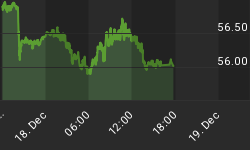While a student at New York University, Alan Greenspan belonged to a discussion group some now call the Ayn Rand cult, in which his nickname, appropriately enough, was the undertaker. In describing her adoring pupil, the Russian emigre was once quoted as saying "Alan is so brilliant, but such a social climber." Personal ambition was his guiding light and once Federal Reserve Board chairman, his only objective was to retain the position. Not surprisingly then, he bent easily to the will of Congress, presidents, Wall Street, and, eventually, an emboldened mob of global speculators. His designated successor, Ben S. Bernanke, is cut from the same cloth: the chairman's seat is his lifelong goal and he will give his political and financial constituencies what they want to keep it. Above all, this implies preventing a collapse of the epic US debt bubble by any means possible. Only one obstacle stands between him and success, the $40 trillion bond market and the $100 trillion of interest rate derivatives pyramided upon it. Faced off against this leviathan, the Fed, with its puny $1 trillion balance sheet, will fail.
Unintended euthanasia
After decades of exponential debt growth, the Fed now faces an impossible task: keep debt growth above interest charges or risk liquidation by the marginal debtor setting off cascading cross-defaults. Annual interest charges on outstanding debt of $40 trillion currently total around $2 trillion. With interest rates in a cyclical uptrend since the benchmark 10-year Treasury bottomed at 3.09% on 16 June 2003, interest charges are accelerating. Meanwhile, annual debt growth remains robust at $3 trillion, but the rate of increase is subsiding. Given that about half of this debt growth stems from mortgage financing, the nascent slowdown in the US housing market suggests debt growth is poised to slow substantially. A crossover of interest charges and debt growth appears likely during the next 24 months.
Those projecting a replay of the 1970s in US financial markets should bear in mind that today's bond market is not only many times larger than it was then, there are now more than $100 trillion in contracts that derive their value from it. This is a vast and skittish crowd that will not sit idly by should Dr Bernanke begin to debase the value of their holdings through willy-nilly debt monetization. They will sell, driving interest rates higher and causing interest charges to outrun debt growth. Marginal debtors, unable to service their debt, will be forced to liquidate. Without a liquidity buffer in the form of savings or a current account surplus, the transition to cascading cross-defaults would be seamless. As a result of the reaction of bondholders, Dr Bernanke's prescribed medicine for preventing a collapse of history's most extreme debt bubble is tantamount to monetary system euthanasia.
Leaving the Fed to wither
Federal Reserve Notes (FRNs) cannot survive cascading cross-defaults. In the Fed's balance sheet, these notes are backed by Treasury debt. The value of FRNs, therefore, rests on the ability of the US Treasury to service its debt, or, in other words, the capacity of the US government to tax and borrow. In the wake of cascading cross-defaults, taxation capacity would be decimated. The Treasury would need to borrow more to continue servicing its $8 trillion debt.
Dr Bernanke stands ready to facilitate this new borrowing. He is eager to create new dollar entries in the Fed's balance sheet and swap these for new Treasury debt, in what would amount to a transfer of purchasing power away from existing bondholders. The effect is akin to the dilution suffered by existing shareholders when a company carries out a new stock offering to raise capital. Foreigners, who own half of all outstanding Treasuries, could not be coerced into accepting the uncompensated losses that such a scheme implies. Their exit from the Treasury market would make borrowing prohibitively expensive, putting the government in a position where it can neither tax nor borrow effectively. At this point, the Fed's usefulness would be in serious doubt and confidence in the notes backed by its balance sheet in tatters.
Alan Greenspan and others with an appreciation of monetary tradition might assume that falling confidence in FRNs would be arrested at some point by the Fed's 9,000 ton gold holding. Wishful thinking. Not only is it uncertain how much gold remains since it has not been audited for some 40 years, it is actually owned by the Treasury, not the Fed. With the Fed unable to adequately finance the Treasury, the government may rescind the Fed's authority over the US gold reserve, thereby removing the final prop supporting confidence in its notes. A discredited Fed, with Dr Bernanke at its head, would provide the required receptacle to place the blame for the failure of the monetary system and clear the way for the issuance of a new currency. While those with unquestioned faith in modern central banking may find this outrageous, history reminds us that it is an all too familiar story, even in the US, where the Fed itself was preceded by two failed central banks, both called the Bank of the United States. If we learn anything from history, it is that we do not learn from history.
















